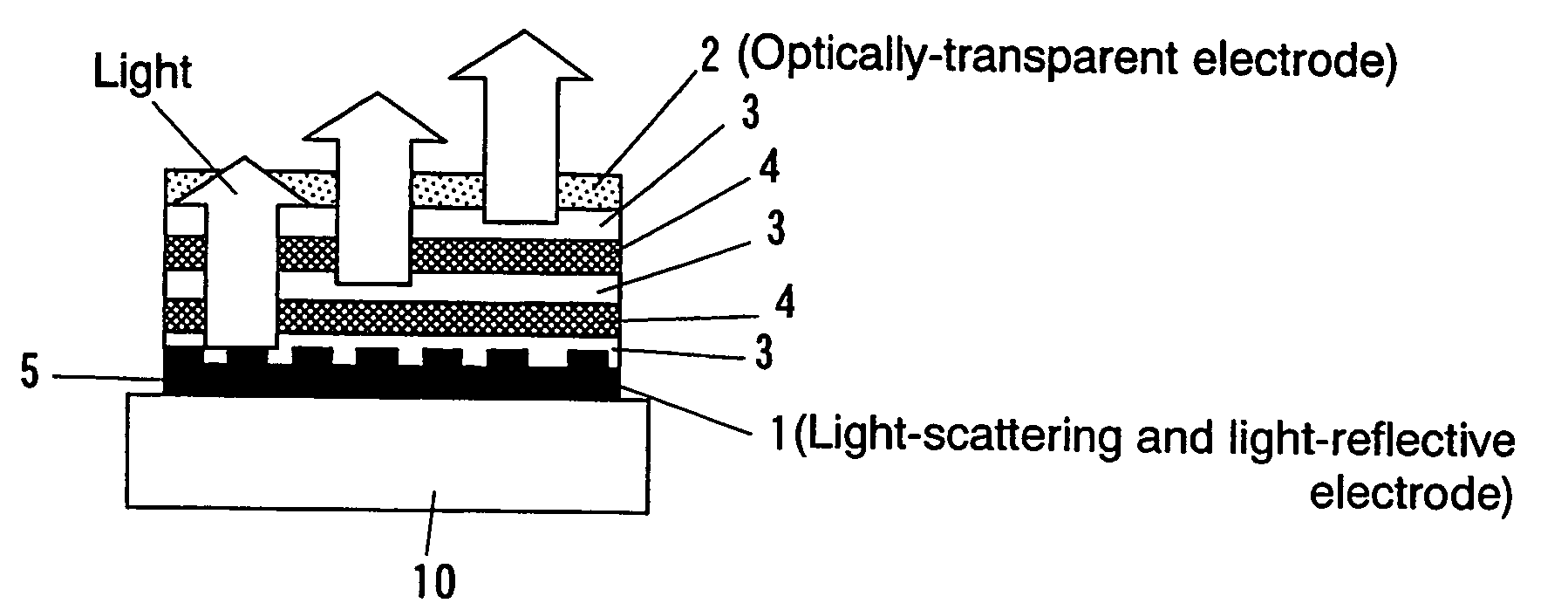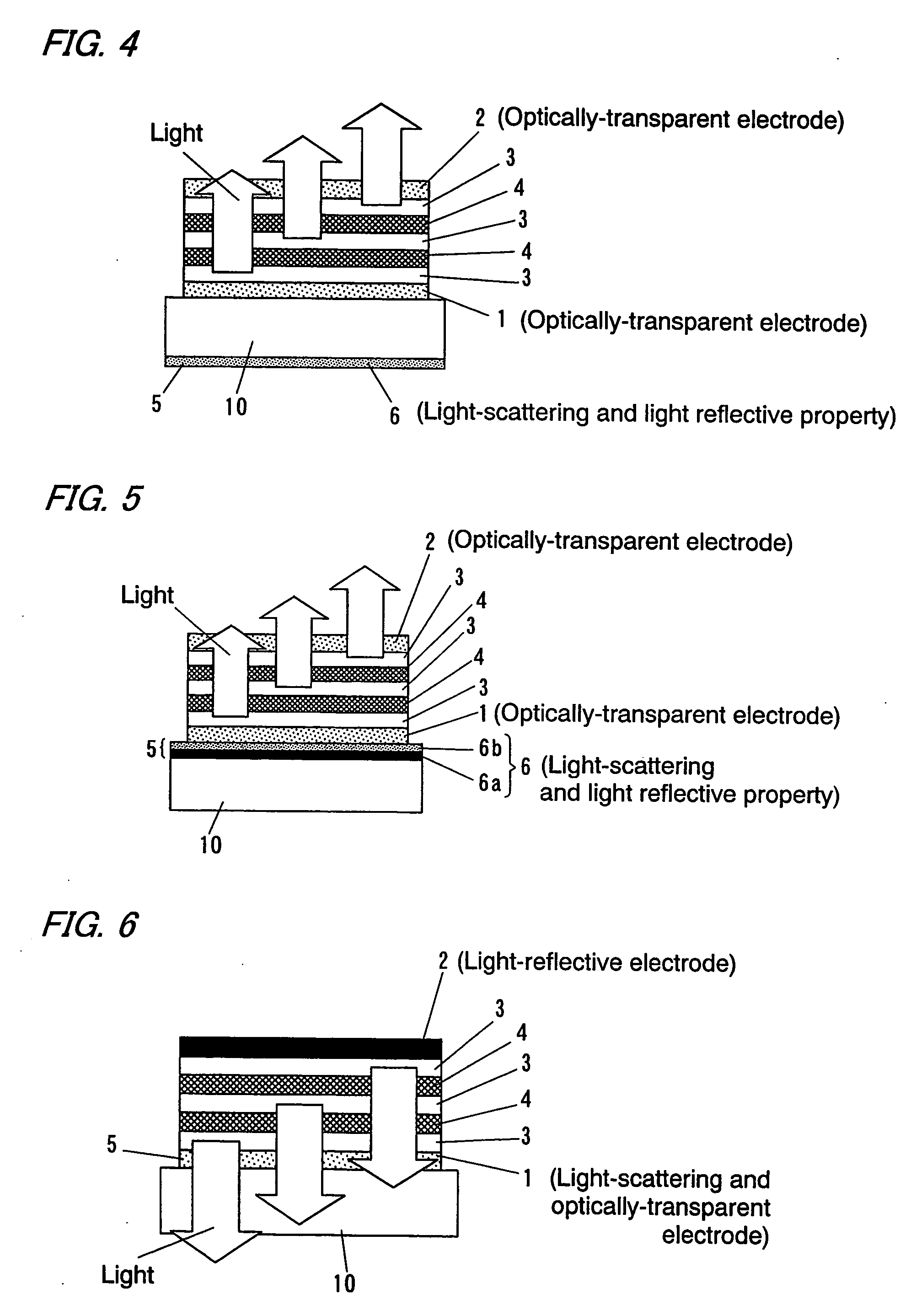Organic Light Emitting Device
- Summary
- Abstract
- Description
- Claims
- Application Information
AI Technical Summary
Benefits of technology
Problems solved by technology
Method used
Image
Examples
example 1
[0083]Silica particle slurry which was 500 nm in average grain diameter was applied on a substrate 10 of alkali-free glass and was dried, and then it was baked at 600 degrees for 50 minutes. Average plane roughness of the surface of the substrate 10 was 130 nm, and maximum vertical interval thereof was about 2 μm. Then, the surface of the substrate 10 was cleaned by ultrasonic cleaning using acetone and isopropyl alcohol, and UV / O3 cleaning, and then a film of Cr was formed on the surface of the substrate 10 to a thickness of 2200 Å by sputtering, and a Al film which was 800 Å in thickness was formed thereon by vacuum deposition, whereby an light-scattering and light-reflective electrode (cathode 2) was formed.
[0084]Next, the substrate 10 was set to a vacuum evaporation system, and an electron injection layer was formed on the cathode 2 by co-depositing bathocuproine (manufactured by DOJINDO LABORATORIES Corporation) and Cs at molar ratio of 1 to 1, to a thickness of 200 Å, under a ...
example 2
[0087]An ITO thin film was formed by sputtering on a surface of a substrate 10 formed by an alkali-free substrate glass plate having a thickness of 0.7 mm, whereby an optically-transparent electrode (cathode 2) having a thickness of 1100 Å and sheet resistance of 12Ω / □ was formed. The glass substrate 10 and the ITO cathode 2 was etched and cut into a shape shown in FIG. 11A, and then it was cleaned by ultrasonic cleaning using pure water, acetone, and isopropyl alcohol, for ten minutes, respectively, and then it was cleaned by steam cleaning using isopropyl alcohol steam for two minutes and it was dried, and then it was cleaned by UV ozone wash for 30 minutes.
[0088]Then, the surface of the substrate 10 opposite to the surface where the cathode 2 was formed was roughened by sandblast with roughness of #220, and then an Al film having a thickness of 1000 Å was formed on the roughened surface, whereby a light-scattering and light-reflective element 6 was formed.
[0089]After that, as is ...
example 3
[0090]As is the case with the second example, an organic light emitting device was manufactured according to the example 1, using the substrate 10 on which the light-scattering and light-reflective element 6 was formed on the opposite surface of the cathode 2. However, a film thickness and a layer construction were as follows. An electron injection layer having a thickness of 200 Å and comprising a co-deposition layer of bathocuproine and Cs of molar ratio of 1 to 1, an electron transport layer having a thickness of 500 Å and comprising only bathocuproine, an emission layer having a thickness of 300 Å and formed by co-deposition of Alq and rubrene with 7% weight fraction of rubrene, a hole transport layer having a thickness of 400 Å, a charge generating layer 4 having a thickness of 100 Å and comprising vanadium oxide, an electron injection layer having a thickness of 200 Å and comprising a co-vapor deposition layer of bathocuproine and Cs of molar ratio of 1 to 1, an emission layer...
PUM
 Login to View More
Login to View More Abstract
Description
Claims
Application Information
 Login to View More
Login to View More - R&D
- Intellectual Property
- Life Sciences
- Materials
- Tech Scout
- Unparalleled Data Quality
- Higher Quality Content
- 60% Fewer Hallucinations
Browse by: Latest US Patents, China's latest patents, Technical Efficacy Thesaurus, Application Domain, Technology Topic, Popular Technical Reports.
© 2025 PatSnap. All rights reserved.Legal|Privacy policy|Modern Slavery Act Transparency Statement|Sitemap|About US| Contact US: help@patsnap.com



